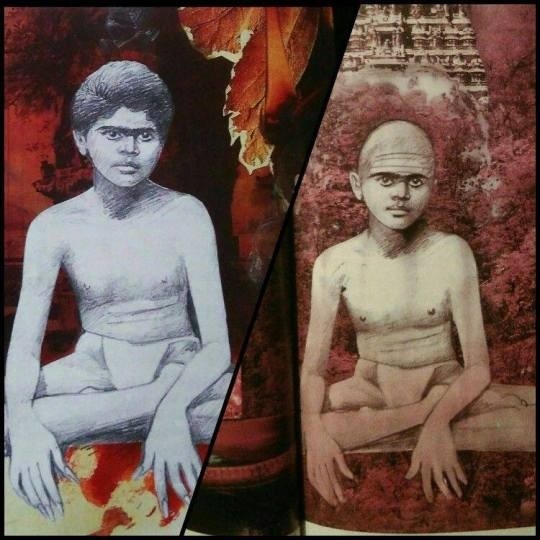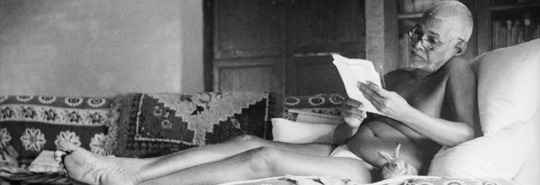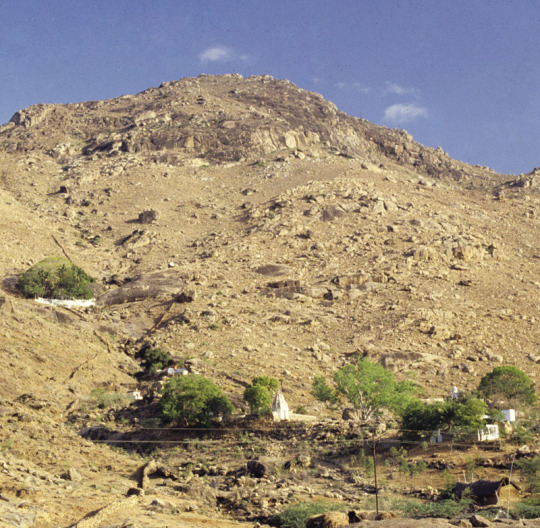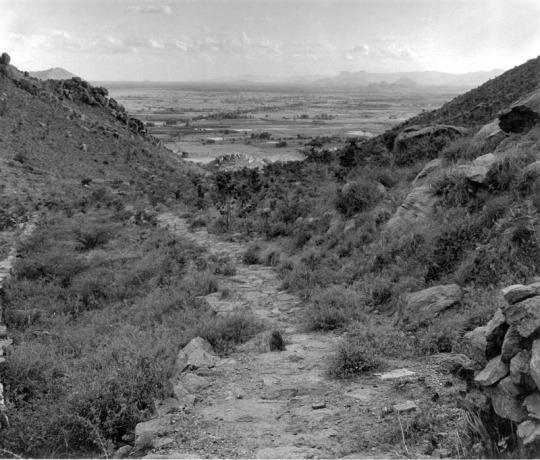#Guhai Namasivaya
Explore tagged Tumblr posts
Photo


https://www.davidgodman.org/bhagavans-deposition-on-arunachala/

A 1949 view of the path to Skandashram on the eastern slopes of Arunachala. Near the top of the photo is the clump of trees around Skandashram.
☀
In the late 1930s Bhagavan made a legal deposition on behalf of the Arunachaleswara Temple which was fighting to retain control over a portion of Arunachala. In his submission Bhagavan spoke about his own relationship with the hill and provided evidence of the historical sanctity of the mountain.
☀

Bhagavan’s Deposition on Arunachala - I
Until the 1930s the eastern slope of the mountain of Arunachala was administered by the Arunachaleswara Temple in Tiruvannamalai. Prior to 1934, its right to do so had been accepted by everyone on and around the hill. From time immemorial the temple authorities had maintained the tanks and temples on the mountain, put out any fires that broke out, and arranged for all the forest produce to be sold in an orderly manner. The unquestioned authority that the temple authorities had wielded over this area had arisen because of the local tradition that the hill was Siva Himself manifesting in the form of a lingam. Since the belief was widespread and largely unchallenged, the local people felt that it was natural and correct that the main temple in Tiruvannamalai should administer all affairs pertaining to the hill.
This traditional arrangement was challenged by the Government of India in 1934. In May that year the Government issued a notification in the district gazette which stated that the whole of Arunachala was a reserve forest and was thus the property of the Government of India. The temple authorities challenged the Government’s order in court, maintaining that the temple was the legitimate owner of 1,750 acres on the eastern side of the hill. This area included all the tanks and temples on the slope of the mountain that begins at the back of the Arunachaleswara Temple.
One of the temple trustees approached Bhagavan and requested him to give evidence to the court that would support the Arunachaleswara Temple’s claim to the land. Bhagavan agreed and in 1938 lawyers for the plaintiff and the defendant came to the ashram to hear his evidence and to cross-examine him on it. Bhagavan’s initial evidence took the form of a written deposition. A small part of this deposition was recorded in Talks with Sri Ramana Maharshi, talk no. 492. The full text is given below.
I came to Tiruvannamalai in the year 1896 and lived on the hill from 1899 to 1922. In that year this ashram was started, and since then I have been living here [at Sri Ramanashram]. From the time I first lived on the hill, all the hill areas have been in the possession of the Devasthanam [the Arunachaleswara Temple authorities]. The ashram on the hill where I used to live was started in 1902. The building which is there now was completed in the year 1916. This particular ashram was built with the permission and kindness of the Devasthanam. [The permission was oral, for no written Government order or permission was ever received]. From the year 1899 until a date a few years after I left Skandashram, the front side [the eastern slope] of the hill was never in the possession of the Government.
Having given his views on the ownership of the hill, Bhagavan then cited a few examples of how well the temple authorities had administered the hill during the period when he had been living on it.
[Many years ago] a man called Saraswathy Swami lived on the hill. That Swami advertised that he intended to perform a ceremonial worship of an image of Lord Subramania [on the hill]. The Devasthanam objected and stopped it. In an official notice they said that the hill itself is linga swarupa [God in the form of a lingam] and that to perform worship of another deity on it, and to celebrate a festival there, was against the tradition of the sastras. On another occasion, when my mother attained [samadhi], they raised a precautionary objection that her samadhi should not be on the hill. They feared that we might build her samadhi on the hill itself. On this occasion also their objection was that the hill was Iswara swarupa [God’s own physical form].
In those days the Devasthanam authorities gave out orders that the wood cutters should not cut the trees on the hill. Every year during the time I was on the hill the Devasthanam gave licences to various people to cut the grass and to collect the other forest products. Whenever there was a fire on the hill, it was put out at the expense of the Devasthanam. On one occasion when we happened to cut some of the cacti that were causing an inconvenience to the ashram, and then burned them, the Devasthanam objected, saying that we should not have a fire in that place. All these incidents took place on the eastern slope. This eastern slope has fixed boundaries.
Bhagavan then went on the describe why the hill was sacred and why, in his opinion, the temple authorities should be allowed to administer it.
There is an aitikya [tradition] that this hill is linga swarupa, that is to say, that this hill itself is God. This aitikya is not to be found anywhere else. That is the cause of the glory of this place. The tradition of this place is that this hill is the form of God and that in its real nature it is full of light. Every year the Deepam festival celebrates the real nature of the mountain as light itself. Authority for this is found in the Vedas, the Puranas and in the stotras [poems] of devotees. Because this tradition maintains that this hill is Siva swarupa, the practice of giri pradakshina, walking clockwise around the mountain as an act of reverence or worship, has arisen. I also have faith in giri pradakshina and have had experience of it.
There is no sastra to separate the hill from the temple. The inseparability of the hill and the temple can be observed during Kartikai Deepam when the festival [of kindling the light] is conducted simultaneously in the temple and on the summit of the hill. Further proof of the tradition that the hill is the form of God can be found in the bi-annual festivals in which the image of Arunachaleswara in the temple performs pradakshina of the hill.
In the account in Talks with Sri Ramana Maharshi Bhagavan is reported to have also said:
‘Siva always remains in three forms: 1) as parabrahman; 2) as linga (here as the hill); and 3) as siddha.’
The third category refers to Siva in the form of Arunagiri Yogi whom Bhagavan said resides on the north slope of the hill. Although this quotation summarises views that Bhagavan had expressed on other occasions, there is no record of this remark in the court transcript.

The bare eastern slope of Arunachala around 1980. The trees midway up the photo on the left are the ones at Skandashram. The gopuram in the centre, near the bottom of the photo, is the entrance to Guhai Namasivaya Temple.
Bhagavan continued:
In accordance with the tradition that the hill is Iswara swarupa, the Devasthanam performs abhishekam to the top of the hill in the same way that it would do to a lingam. For the last ten to twelve years the cauldron that contains the Deepam light on the top of the hill is carried to the summit every year during the festival. Prior to this, for many, many years, the cauldron was left there throughout the year.
I am a devotee of Arunachaleswara. I have composed a poem in Tamil which says that the Arunachala hill is Iswara swarupa.
The Government’s lawyer objected to Bhagavan introducing this poem as evidence, but the objection was overruled. It seems that no one recorded the original Tamil verse. It now only exists in the following English translation:
Lord Arunachala appeared out of the hill and at the request of Brahma and Vishnu merged back in the hill. Simultaneously he manifested as the lingam at the bottom of the hill. The hill continues to represent the Lord.
A similar idea, which may be derived from this verse, can be found in the account in Talks with Sri Ramana Maharshi:
‘Siva originally appeared as a column of light. On being prayed to, the light disappeared into the hill and manifested as [a] lingam. Both are Siva.’
After Bhagavan had submitted his verse, the case was adjourned for five days. On its resumption, Bhagavan added a few extra comments on the traditions and mythology of the hill.
Even after this [the time when Siva appeared to Brahma and Vishnu in the form of Light] Ishan [Iswara] appeared to Devi in the form of Light before disappearing graciously into the form of the hill.
There are many ancient tirthams [sacred tanks] that exist on the hill. Among them the Mulaipal Tirtham and the Pada Tirtham, are important. There is a tradition that these tirthams were created by Siva and Parvati for the sake of Guhai Namasivaya.
The Government’s lawyer then began his cross-examination of Bhagavan, questioning him in detail on some of the statements he had made. Only Bhagavan’s answers are recorded in the court transcript. I have separated the text into paragraphs in such a way that I hope each paragraph constitutes a different answer. I leave the reader to infer what the questions might have been.
I lived in Virupaksha Cave for sixteen years. I lived in Skandashram for six years. I have stayed at this place [Sri Ramanashram] since 1922.
I constructed a building at Virupaksha Cave. No written permission was obtained from anyone for the construction of the building.
Skandashram was started in 1902. The building was completed in the year 1916. Even after that date some construction work was carried on.
At first it [Skandashram] began as a tirtham. Later it developed into a place of residence. Before Skandashram came into existence, moisture was found in another location nearby. Its source was in a rock that was twenty yards away. This tirtham is now located between Skandashram and Virupaksha Cave. It was only later that the Skandashram tirtham came into being.
Because it [Skandashram] was built by a person called Kandan who lived in the ashram, by his own hands, it became known as Skandashram. That tirtham [I just spoke about] is attached to that ashram.
No order was received from anyone for building this ashram [Skandashram]. Because I was staying there, no one objected. On the contrary, they approved of it.
During the time I lived on the hill, no written order was ever obtained from anyone to make living facilities. Nor was any order obtained when repairs were carried out in some of these places.
They were not done on my authority; others did them as their own work. I did not tell them to build, nor did I prevent them. In this manner Skandashram, Virupaksha Cave and Sri Ramanasramam came into being. The other ashrams on the hill also came into existence in this way. No written orders were received for their construction.
I knew about the notice issued to Saraswathy Swami by the Devasthanam. But I do not remember the year in which it happened. I heard that the notice had been given.
During the period I was on the hill, a vel [spear] and a statue were in the temple [of Subramania]. They [the Devasthanam] did not object to the statue being kept in that place; their objection was to popularising it through public celebrations.
There are places to stay both at Virupaksha Cave and Guhai Namasivaya Temple. It is not known whether they contain the samadhis [of the two saints who founded them]. In Guhai Namasivaya there is a lingam. In Virupaksha Cave there is an altar. In Guhai Namasivaya puja and abhishekam are done to the lingam. At the altar in Virupaksha Cave, only puja is done. It is the popular belief that both of these places are samadhis.
The time when Virupaksha Deva and Guhai Namasivaya attained samadhi may be around 300 or 400 years ago. I do not know when the buildings were first started in those places.
It is stated in the Upanishads and in the Skanda, Linga and Siva Puranas that this hill is Iswara swarupa.
I cannot say without referring to the books in which Upanishad and in which place it is stated so.
There was a jadai swami [a swami with long matted locks] who used to live on the hill. He died there. His body was brought down to the foot of the hill and interred. The same thing happened to Palaniswami. A samadhi cannot be made on the hill for anyone who dies there. They can only be burned after bringing them to the foot of the hill. Once a person died near Seven Springs [two thirds of the way up the mountain]. His samadhi was also made at the foot of the hill.
Jadai Swami attained samadhi about four of five years ago. The others attained samadhi after 1901 and before 1920.
I had no thought of having my mother’s samadhi on the hill. I did not tell anyone that the samadhi should be made on the hill.
I have omitted several of Bhagavan’s answers. Some of them merely repeat what he said earlier while others pertain not to Arunachala but to rather mundane matters of ashram administration.
~ David Godman
☀ ☀ ☀ Continues in “Bhagavan’s Deposition on Arunachala - II”

The path from Skandashram to Ramanasramam before it was reforested in the 1990s.
☀
#Bhagavan Sri Ramana Maharshi#David Godman#Arunachala#Bhagavan’s Deposition on Arunachala#Guhai Namasivaya#skandashram#virupaksha#Iswara swarupa#God in the form of a lingam#linga swarupa#Arunachala Linga#The Holy Beacon#Karthigai Deepam Festival#festival of lights#pillar of light#jyothi#jyoty#Skanda Mahapurana#Siva Mahapurana#Arunachala Mahadeepam Cauldron#cauldrom#giri pradakshina
11 notes
·
View notes
Text
Sri Arunachala Ashtakam & Guhai Namasivaya Cave
Sri Arunachala Ashtakam & Guhai Namasivaya Cave
Presenting Sri Arunachala Ashtakam (eight verses to the sacred Arunachala Hill) by Bhagavan Ramana Maharshi, based on the work of the Tamil saint Guru Namasivya, who lived in Tiruvannamalai circa 15th/ 16th Century AD and was an ardent devotee of Shiva, much like Ramana many centuries later. The Arunachala Hill is taken as a form of Lord Shiva, and Bhagavan Ramana at one point of time in the…
View On WordPress
0 notes